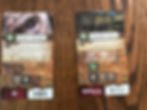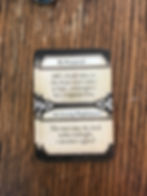Spooky month part 3: Elder Sign
- Chris
- Oct 12, 2021
- 8 min read
Updated: Aug 16
Welcome back to spooky month, where I'm reviewing all the games in Fantasy Flight's Arkham Files series. In part 1, I reviewed Arkham Horror: 2nd Edition, a massive game with a print run spanning 2005 to 2011. In part 2, we explored the luxurious Mansions of Madness which hit shelves in 2011. But Mansions wasn't the only Arkham game to come out that year, so let's take a look at its smaller companion, Elder Sign.

Elder Sign is a dice game. If you've been playing board games for a while, you may have noticed that publishers will put out a smaller, lighter dice-based variant of a successful board or card game. Catan Dice Game, Zooloretto: the Dice Game, Bang!: The Dice Game, Pandemic: The Cure (oooh, an original title! That's nice), Dark Moon (basically Battlestar Galactica: the dice game) . . . the list goes on and on and on, and in 2011, the list gained Elder Sign, or as I think of it: Arkham Horror: The Dice Game.
The purpose of a dice game is to distill the core elements of a larger and more complex game. Arkham Horror is VERY large and complex, so a quick and easy dice game seems like a good fit. Let's check it out!

Elder Sign is set in the Miskatonic University Museum. The collection of powerful relics and mysterious artifacts housed in the museum frequently attracts the attention of otherwordly entities and Ancient Ones. And now, one of these Ancient Ones has concocted a plan to enter our universe through the museum. It is up to the investigators to explore the museum and place enough elder signs throughout the exhibits to block the Ancient One from destroying our world. Like Arkham Horror, it is a cooperative game for 1-8 players.
This sounds really familiar, doesn't it? Many of the investigators from Arkham Horror and Mansions of Madness return in Elder Sign, as well as the monsters and Ancient Ones we have come to know and love. Instead of a static board, Elder Sign uses a deck of location cards to represent the different parts of the museum. On an Investigator's turn, they can take a mundane action in the museum lobby (such as purchasing something from the gift shop or rummaging through the Lost and Found), or they can go explore a museum location.
Each location has a set of conditions that the investigator must complete in order to successfully investigate. The player must roll the six standard dice and look for results that match the criteria on the card.

In the picture above, the "When Night Falls" location requires the following dice results: Terror, Skull, and two Lore. The white border indicates that if a monster appears, it can attach to that location and make it more difficult to investigate. You'll roll the six green dice and try to find results that match either row of symbols. If your results match the entire row (so in this case, either a single terror symbol, or the skull and two lore), you can lock in those dice by placing them on their matching spaces on the location card. Then you can re-roll the rest to try and complete the remaining rows.
If they don't fully match, you must discard one of your dice to re-roll the remainder. You can also save one of the results on your player sheet to slightly improve your odds. So if your dice roll resulted in one skull but no scrolls, you can save the skull, discard one of the other dice, and re-roll the rest to try and get those scrolls. You can continue re-rolling if necessary, but you must discard a die each time. You'll keep rolling until you fail, or until it is impossible to succeed.
If you investigator succeed, you'll receive the reward in the bottom-right square of the card. This could be a clue token, an item card, or even an elder sign token. If you fail, you receive the punishment in the bottom-left square. Punishments could cause physical or mental damage, spawn a monster in the museum, or add to the doom track on the Ancient One sheet.

After the investigator's turn, the clock track advances 3 hours (or a quarter circle, if you prefer). When the clock strikes midnight, one player draws a Mythos Card. Every Mythos card has an immediate effect (which could just be no effect) and an ongoing effect for the next 12 hour period (which could also just be no effect). Just like in Arkham Horror, they exist just to make your life a little harder. Or a lot harder! Welcome to Arkham!
Investigators have access to a number of item cards as well. They can heal investigators, let players re-roll dice, or grant access to the two special dice. The yellow die is better than the standard green dice, and the red die is even better still. Adding these extra dice to your dice pool improves your odds of success on any investigation attempt. Unfortunately, every item in Elder Sign is one time use before being discarded to the bottom of the deck. The item decks in Elder Sign are extremely small, though, so in games with three or four players it is normal to see the same items reappear over and over.
Elder Sign's spells work a little differently: most spell cards have one or two empty boxes, and during an investigation you can store one of your dice in the box to save it for later. You can even save dice for future turns, but bear in mind this means the other players have one fewer die for their turns. You can even donate your stored die to another player to use on their turn! When you finally choose to spend the die from your spell card, that card gets discarded. Like items, spells are one-time use.

Fighting monsters functions exactly like investigating a location. You have to get certain results on your die roll and lock them onto the monster tile. If you fill up the tile, the monster dies. Otherwise, you keep re-rolling until they're defeated. But you will only encounter monsters while investigating a location. You have the same pool of dice to defeat the monster and investigate on yoru turn, so if you don't roll really well, you might fail to accomplish either or both goals. You may defeat the monster and claim the trophy, but still fail the investigation and suffer that penalty.
Are you still following this? Because there's actually more that I haven't really gotten into yet, like saving dice for other players, spending location and monster trophies, and more. I meant for this to be a rough overview, but the mechanics are so specific and convoluted that they do not make sense at all if you're not thorough. And like many early 2010s Fantasy Flight games, this game suffers from a poor rulebook. It's fairly short at least, but it's confusingly laid out and has trouble explaining the proper order of operations for conducting an investigation. I ended up printing out a flow chart from boardgamegeek.com because I was just so confused, and that helped a lot. When you need a flow chart to properly understand how to play a dice game, you know the rules are too complicated.

Aside from the complexity, Elder Sign also suffers from the same problem as Arkham Horror: narrative incoherence. Why is there a random Flying Polyp floating in the basement when C'Thulhu is about to break through into our world? Who knows, just kill it and move on. The location cards have minimal flavor text, and the item cards have none. All you have is one or two sentences on the location cards and monster tokens. Without any narrative to guide the story, Elder Sign is just a mechanically confusing game about rolling and re-rolling dice. And you know what, Yahtzee works the same way and is WAY easier to learn. Elder Sign introduces complexity in an attempt at creating interesting strategic decisions. But all it does is obfuscate the process. The winning strategy is to play use your item cards to access the yellow and red dice as much as possible, and to prioritize drawing more item cards so you can use the yellow and red dice even more. If you do this, you'll win most games of Elder Sign you play.
Still, Elder Sign does one thing well: it won't take up your entire evening (once you figure out the rulebook). At roughly 60 minutes, you'll have plenty of time for other games afterward. And that's great and all, but if you're going to spend all that time figuring out the rules and navigating the flowchart, I want to have a memorable experience come out of it. As it stands, Elder Sign just feels really sparse.
But Fantasy Flight is not known for sparse games, and they weren't about to start with this one! In 2013, they released Elder Sign's first expansion, and four more followed between then and 2018. And . . . once again I haven't played any of them. I know they add great new stuff, like new mechanics, special dice, extra Ancient Ones, and more. I've considered getting a couple of them at times, but in the end this game just doesn't get played. Most of my friends want to play something easier to pick up and play, and if I try hard I might be able to convince them to give Elder Sign a try. But the friends who really want that Arkham experience would rather play the bigger, longer games and really immerse themselves in the world. Elder Sign is too simplistic for the hardcore fans, and too overly complicated and slow for more casual fans. But most egregious of all: I have never finished a game of Elder Sign and heard a friend say "Wow, that was fun! I can't wait to try it again with a different set up!"
So where does that leave Elder Sign? It's certainly not perfect. It's both too complicated and too simple, which has some metatextual appeal but isn't great for a board game. It's longer than most dice games should be, but much shorter than any other Arkham Files game. It can scratch that cosmic horror itch in under 60 minutes, but you will come away wishing you had enough time to play one of the better games in the series. You could play Elder Sign, but you really shouldn't.
Thanks for reading my Elder Sign review! We're three games into Spooky month, but the best is still to come! Next time, we'll be reviewing Fantasy Flight's attempt to rebuild Arkham Horror into a more narratively coherent experience while retaining all of the core elements that fans know and love. That's right, it's time for Eldritch Horror! See you then!

